Weißrussland | |
|
|
| Übersicht – Contents: | |
Weißrussland | |
|
|
| Übersicht – Contents: | |
Flaggen – Flags: |
|
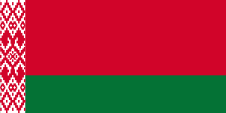 |
Nationalflagge –
national flag, Seitenverhältnis – ratio = 1:2, Quelle/Source nach/by: Wikipedia (D) |
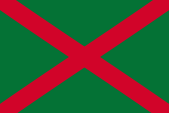 |
Flagge des Grenschutzes – flag of the border patrol, Seitenverhältnis – ratio = 2:3, Quelle/Source nach/by: Wikipedia (D) |
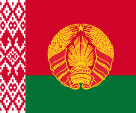 |
Flagge des Präsidenten – flag of the president, Quelle/Source nach/by: Wikipedia (D) |
historische Flaggen – historical Flags: |
|
 |
1917–1919, Nationalflagge – national flag, Seitenverhältnis – ratio = 2:3, Quelle/Source nach/by: Wikipedia (D) |
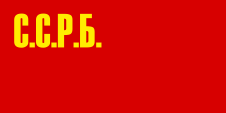 |
1919, Flagge der Soz. Sowjetrepublik Weißrussland – flag of the Soc. Soviet Republic of Belaus, Seitenverhältnis – ratio = 1:2, Quelle/Source nach/by: World Statesmen |
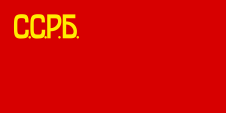 |
1920–1927, Flagge der Soz. Sowjetrepublik Weißrussland – flag of the Soc. Soviet Republic of Belaus, Seitenverhältnis – ratio = 1:2, Quelle/Source nach/by: World Statesmen |
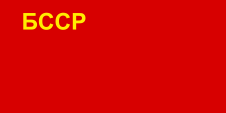 |
1927–1937, Flagge der Weißruss. Soz. Sowjetrepublik – flag of the Belarus. Soc. Soviet Republic, Seitenverhältnis – ratio = 1:2, Quelle/Source nach/by: World Statesmen |
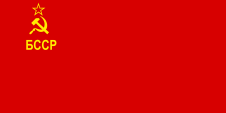 |
1937–1951, Flagge der Weißruss. Soz. Sowjetrepublik – flag of the Belarus. Soc. Soviet Republic, Seitenverhältnis – ratio = 1:2, Quelle/Source nach/by: World Statesmen |
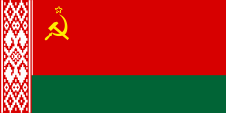 |
1951–1991, Flagge der Weißruss. Soz. Sowjetrepublik – flag of the Belarus. Soc. Soviet Republic, Seitenverhältnis – ratio = 1:2, Quelle/Source nach/by: World Statesmen |
 |
1991–1995, Nationalflagge – national flag, Seitenverhältnis – ratio = 1:2, Quelle/Source nach/by: Wikipedia (D) |
 |
1991–1995, Nationalflagge – national flag, inoffizielle Variante mit Wappen – unofficial variant with coat of arms |
 |
1995–2012, Nationalflagge – national flag, Seitenverhältnis – ratio = 1:2, Quelle/Source nach/by: Wikipedia (D) |
regionale Flagge – regional Flag: |
|
 |
Flagge der islamischen
Tataren in Weißrussland – flag of the muslim Tatars in Belarus, Seitenverhältnis – ratio = 2:3, Quelle/Source nach/by: Wikipedia (D) |
Bedeutung/Ursprung der Flagge – Meaning/Origin of the Flag: |
|
| Die weiß-rot-weiße bürgerliche Flagge Weißrusslands erschien unmittelbar nach der Abdankung des russischen Zaren im Jahre 1917, und geht auf die heraldische Figur des weißen Ritters von Litauen zurück (Pahonia). | The white-red-white flag appeared immediately after the abdication of the Russian Tsar in 1917 and has its roots in the heraldic figure of the White Knight of Lithuania (Pahonia). |
| Nach einer anderen Theorie repräsentieren die Farben den Namen des Landes, Weiß = "Bela", Rot = "Rus". Aus dem Wort "Rus" leitet sich der Name "Russland" ab, denn es bezieht sich auf die rotblonden Haare der Normannen, der Urväter des russischen Staates. | According to another theory, the colours represent the name of the country, White = "Bela", Red = "Rus". From the word "Rus" is derived the name of "Russia" because it refers to the reddish-blond hair of the Normans, the forefathers of the Russian state. |
| Nach einem erfolgreichen kommunistischen Putsch wurde Jahre 1919 eine einfarbige rote Flagge mit den goldenen Initialen "SSRB" im Obereck eingeführt, die etwa 1937 um einen goldenen Hammer und Sichel ergänzt wurde. Am 25.12.1951 wurde eine neue Flagge eingeführt. Sie zeigte zwei Streifen in Rot und Grün im Verhältnis 2:1, und am Liek auf einem roten senkrechten Balken ein Volkskunst-Ornament und im Obereck des roten Streifens Stern, Hammer und Sichel. Rot steht für Kommunismus, Grün für die Wälder und Landwirtschaft. Das rot-weiße Ornament symbolisiert die Geschichte des Landes. | After a successful
communist coup d’etat in 1919 a single coloured red flag with the golden initials
"SSRB" in the upper canton was introduced, to which, perhaps in 1937, were added
a golden hammer and sickle. On the 25th of December 1951 a new flag was introduced. It showed two stripes of red and green in the ratio 2:1, and at the leech on a red vertical bar a folk art ornament and in the upper canton of the red stripe star, hammer and sickle. Red stands for communism, green for the forests and agriculture. The red and white ornament symbolizes the history of the country. |
| Am 19.09.1991 wurde im Obersten Sowjet der Unabhängigen Republik Weißrussland beschlossen, die bürgerlichen Staatssymbole aus den Jahren 1917 bis 1919 wieder einzuführen. | On the 19th of September 1991 it was decided in the Supreme Soviet of the Independent Republic of White Russia, to reintroduce the civil state symbols of the years 1917 until 1919. |
| Nachdem A. G. Lukaschenko im Jahre 1994 Präsident geworden war, forcierte er im Rahmen seiner prosowjetischen Politik die Wiedereinführung der alten Symbole. So wurde von Veteranenrganisationen, natürlich unter Leitung des Staatspräsidenten Lukaschenko, am am 14.05.1995 eine Volksabstimmung über die Staatssymbole initiiert. Jedoch waren vorher kleine Änderungen empfohlen worden. Der Hammer, die Sichel und der Stern entfielen, und das Ornament erschien in Rot auf Weiß. Die neue prokommunistische Flagge wurde am 07.06.1995 offiziell eingeführt und später noch einmal leicht abgeändert (senkrechter weißer Streifen). Der gleiche Volksentscheid beschloss auch über das neue alte Staatswappen. Es wurde am 07.06.1995 offiziell eingeführt. Die Farben der Nationalflagge sind in der "Verordnung STB 911-2008 Nationalflagge der Republik Belarus" geregelt. Sie werden folgendermaßen angegeben: Rot = Pantone 186, Grün = Pantone 356. | After A. G. Lukaschenko
had become president in 1994, he, as a part of his pro-soviet policies, forced the
reintroduction of the old symbols. This way a referendum about the state symbols was
initiated by veterans organizations, of course under the leadership of President
Lukaschenko, on the 14th of May in 1995. Ahead of this, however, a few changes were recommended. The hammer, the sickle and the star were removed, and the ornament appeared in red on white. The new pro-communist flag was officially introduced on the 7th of June 1995, with a few minor changes at a later date (a vertical white stripe). This referendum also decided over the new old coat of arms of the state. It was officially introduced on the 7th of June 1995. The colors of the national flag are regulated in the "Order STB 911-2008 National flag of the Republic of Belarus". They are indicated as follows: Red = Pantone 186, Green = Pantone 356. |
| Am 20.02.2012 wurden einige kleine Änderungen an der Flagge beschlossen. Die schmalen roten Streifen links und rechts des Volkskunst-Ornaments sind wurden entfernt, es reicht jetzt direkt bis zum Rand, und die Breite des Ornaments wurde auf ein Neuntel der Flaggenbreite festgelegt. | On 20th of February in
2012 some small changes for the flag were adopted. The narrow red stripes on the left and right of the folk art ornament became removed, it reaches now directly to the edge, and the width of the ornament is set to one-ninth of the width of the flag. |
| Quelle/Source: Flaggen und Wappen der Welt, Flags of the World, Die Welt der Flaggen, Flaggen und Wappen, Wikipedia (D) | |
Wappen – Coat of Arms: |
|
 |
1917–1919,
1991–1995, Wappen von Weißrussland – coat of arms of Belarus, Quelle/Source nach/by: Wikipedia (D) |
 |
1981–1991, Wappen der Weißruss. Soz. Sowjetrepublik – arms of the Belarus. Soz. Soviet Republic, Quelle/Source nach/by: Jam123, Public domain, via Wikimedia Commons |
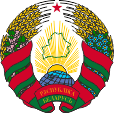 |
1995–2020 Wappen von Weißrussland – coat of arms of Belarus, Quelle/Source nach/by: Wikipedia (D) |
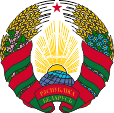 |
seit/since 2020 Wappen von Weißrussland – coat of arms of Belarus, Quelle/Source nach/by: Wikipedia (D) |
Bedeutung/Ursprung des Wappens – Meaning/Origin of the Coat of Arms: |
|
| Das neue prokommunistische Wappen wurde, wie die Flagge, am 07.06.1995 über einen Volksentscheid offiziell eingeführt. Es ähnelt dem Wappen der Sowjetrepublik. | The new pro-communist emblem was, as the flag, officially introduced on 7th of June in 1995 through a referendum. It is similar to the arms of the Soviet Republic. |
| Es zeigt anstelle von Hammer und Sichel eine grüne Konturlandkarte der Weißrussischen Republik in goldenen Sonnenstrahlen oberhalb der Erdkugel. Über der Landkarte befindet sich ein roter fünfzackiger Stern. Das ganze Wappen ist von einem Kranz goldener Ähren, mit von rechts eingeflochtenen Kleeblüten, und von links eingeflochtenen Leinblüten, umgeben. Die Ähren sind anstatt von einem roten von einem grün-roten Band umbunden, welches im unteren Teil die goldene Aufschrift "Respublika Belarus" trägt. | This shows, instead of hammer and sickle, a green outline of the map of the Belorussian Republic (White Russia) in golden sunbeams above the globe. Above the map is situated a red five-pointed star. The whole coat of arms is surrounded by a wreath of golden ears, with inwoven clover blossoms from the right and inwoven flax blossoms from the left. The ears are enveloped by a green-red ribbon instead of a red one, which carries the golden inscription "Respublika Belarus" in the lower part. |
| Im Jahre 2020 wurde das Wappen ein klein wenig abgeändert: Die Kontur der Landkarte wurde von Grün auf Gold abgeändert und der rote Stern ein klein wenig vergrößert. | In the year 2020 the coat of arms was changed a little: the contour of the map was changed from green to gold and the red star was enlarged a little bit. |
| Das bürgerliche Wappen von Weißrussland wird "Pahonia" genannt, und ist das nationale Emblem von Weißrussland und das historische Wappen vieler Städte in Weißrussland. Es entstand im alten Navahradak (Novgorodok), der ersten Hauptstadt des Großherzogtums Litauen. "Pahonia" heißt "Verfolgung" und symbolisiert die Verfolgung eines Feindes in Verteidigung der Heimat. Es war das Wappen des Großherzogtums Litauen, zu welchem Weißrussland über 5 Jahrhunderte gehörte. Im Jahre 1918 übernahm die Weißrussische Demokratische Republik es als Wappen, genauso wie im Jahre 1991 das Parlament der Unabhängigen Republik Weißrussland. | The civil coat of arms
of White Russia is named "Pahonia", and is the national emblem of Belarus and
the historical coat of arms of many cities in Belarus. It originated in ancient Navahradak
(Novgorodok), the first capital of the Grand Duchy of Lithuania. "Pahonia" means "Pursuit" and symbolizes the pursuit of an enemy in defense of the homeland. It was the coat of arms of the Grand Duchy of Lithuania, of which Belarus was an integral part for over five centuries. In 1918 the Belarussian Democratic Republic adopted it as its coat of arms and so did the parliament of the independent Republic of Belarus in 1991. |
| Quelle/Source: Flaggen und Wappen der Welt, Wikipedia (D), Volker Preuss | |
Flugzeugkokarde – aircraft roundel: |
|
 |
Flugzeugkokarde – aircraft roundel Quelle/Source: nach/by Wikipedia (EN) |
| Landkarten – Maps: |
Lage
– Position: |
Landkarte
des Landes – Map of the Country: |
Zahlen und Fakten – Numbers and Facts: |
|
|
|
|
|
|
|
|
|
|
|
|
|
|
|
|
|
Geschichte: |
| 882–1240
· zur Kiewer Rus 1240 · mongolische Eroberung 1322 · zu Litauen 1569 · zu Polen 1654 · Gebietsabtretungen an Russland 1772–1795 · schrittweise Angliederung an Russland 1917 · deutsche Besetzung 25.03.1918 · Proklamation der Weißrussischen Republik 1919 · kommunistischer Putsch, Errichtung der Sowjetrepublik 1919 · Besetzung durch Polen 1920 · sowjetische Eroberung 1921 · Gebietsabtretungen an Polen 1922 · Beitritt zur Sowjetunion (UdSSR) 1941–1944 · deutsche Besetzung 1945 · Angliederung polnischer Gebiete August 1991 · Unabhängigkeit 1994 · Beginn der sowjetischen Restauration |
History: |
| 882–1240
· to the Kiev Rus 1240 · Mongolian conquest 1322 · to Lithuania 1569 · to Poland 1654 · ceding of territories to Russia 1772–1795 · step by step annexation by Russia 1917 · German occupation 25th of March in 1918 · proclamation of the White Russian Republic 1919 · communist coup d’etat, establishment of a Soviet Republic 1919 · occupation by Poland 1920 · conquest by the USSR 1921 · ceding of territories to Poland 1922 · joining to the Soviet Union (USSR) 1941–1944 · German occupation 1945 · annexation of Polish territories August 1991 · independence 1994 · onset of soviet restoration |
| Quelle/Source: Atlas zur Geschichte, World Statesmen, Wikipedia (D), Translator of the English text (partial): Joachim Nuthack |
Ursprung des Landesnamens – Origin of the Country's Name: |
|
| Der Name „Weißrussland“ ist ein wörtliche übersetzung des Wortes „Belarus“, der weißrussische Eigenname des Landes. Der Ursprung liegt in der früher bei den Slawen oder auch bei den Mongolen üblichen Bezeichnung der Himmelsrichtungen mit Farben. Slawisch: Norden = Weiß, Osten = Rot, Süden = Schwarz, Westen = Blau; Mongolisch: Norden = Schwarz, Osten = Blau, Süden = Rot, Westen = Weiß. Der alte lateinische Name Russlands ist Ruthenien, die Ruthenen waren die gemeinsamen Vorfahren der heutigen Ukrainer, Russen und Weißrussen. Ruthenien war vom 13. bis zum 15. Jahrhundert von den Mongolen besetzt oder abhängig, der Zeitraum in dem sich das Volk der Weißrussen herausbildete, und es ist nicht mehr feststellbar, ob mit „Weiß“ nun der Norden oder der Westen gemeint war. „Weißrussland“ heißt also „Nordrussland“ oder „Westrussland“. | The name "White
Russia" is a literal translation of the word "Belarus", the Belarusian
proper name of the country. The origin lies in the past of the Slavs, or even of the
Mongols, and means the traditional designation of the compass with colours. Slavic: North
= White, East = Red, Black = South, West = Blue; Mongolian: North = Black, East = Blue,
Red = South, West = White. The old Latin name of Russia is Ruthenia, the Ruthenians were the common ancestors of the Ukrainians, Russians and Belarusians. Ruthenia was from the 13th to the 15th century occupied or dependent by the Mongols – the period in which emerged the nation of the Belarussians – and it is not possible to determine whether he meant with "white" now the north or the west. "Belarus" means in this way "Northern Russia" or "Western Russia". |
| Ein ähnlicher, heute nicht mehr gebräuchlicher Name ist "Rotrussland", das Ostgalizien der späteren Zeit, also die Region um Lemberg in der heutigen Ukraine. Rotrussland liegt im Osten der ehemaligen Kiewer Rus, ein Hinweis darauf, das hier mit Rot Osten gemeint ist. | A similar name, which is no longer in use today, is "Red Russia", the eastern Galicia of the later period, the region around Lviv (Lwow, Lemberg) in today's Ukraine. Red Russia is placed in the east of the former Kievan Rus, an indication that with Red is meant East here. |
| Der Name
"Russland" geht auf die Staatsbezeichnung der mittelalterlichen Russischen
Staaten zurück, die "Rus". über die Bedeutung des Wortes "Rus" sind
zwei Theorien bekannt: 1.) "Rus" geht auf das germanische Wort für "Rot" zurück, und bezieht sich auf die rotblonden Haare der Normannen, der Urväter des russischen Staates. 2.) "Rus" geht auf das germanische Wort für "Ruderer" zurück, die Finnen nennen die Schweden bis heute "Ruotsi". |
The name
"Russia" has its roots in the medieval name of the Russian states – the
"Rus". About the meaning of the word "Rus" are known two theories: 1st) "Rus" goes back to the
teutonic word for "red" and refers to the strawberry blond hair of the Normans
– the ancestors of the Russian state. |
| Gerne wird auch folgende sehr poetische aber unwahrscheinliche Herleitung des Ursprungs des Namens bemüht. Die Farbe Weiß im Landesnamen sei auf die vielen Birkenwälder des Landes zurückzuführen, deren weiße Stämme das Erscheinungsbild des Landes prägen. | Sometimes is used this
very poetic but improbable derivation of the origin of the name: The color white in the country's name comes from the many birch forests of the country, which characterize – with their white trunks – the appearance of the country. |
| Heute gibt es Versuche mittels politisch gesteuerter Sprachakrobatik einen Unterschied zwischen Belarus als Weißrussland und Russland selbst herbeizureden, weil die Schreibung mit nur einem "s" keine Identifikation mit Russland zulassen würde. Aber, alle ruthenischen Länder haben ihr Wurzel in einem einzigen Staat, der Kiewer Rus, auch in ethnisch gemeinsamen Vorfahren, den Ruthenen. Es spielt dabei keine Rolle, ob diese Länder heute Russland, Ukraine oder Weißrussland heißen. Es handelt sich eindeutig um sogenanntes "framing", das mit der Übernahme von bestimmten, logisch klingenden Formulierungen politisch agitiert und manipuliert. Kurioserweise zeigt sich gerade bei dieser politischen Sprachregelung – mit dem Hinweis auf die Rus mit einem "s" – die Gemeinsamkeit der ruthenischen Staaten. |
Today there are attempts
to implant a difference between White Russia as Belarus and Russia itself by
use of politically controlled language acrobatics, because spelling with
just an "s" would not allow identification with Russia. But, all Ruthenian countries have their roots in a single state, the Kievan Rus, also in ethnically common ancestors, the Ruthenians. It doesn't matter whether these countries are called Russia, Ukraine or Belarus today. It is clearly a matter of so-called "framing", which politically agitates and manipulates by use of special logical-sounding formulations. Strangely enough, this political language regulation – with the reference to the Rus with an "s" – shows the commonality of the Ruthenian states. |
| Quelle/Source: Handbuch der geographischen Namen, Volker Preuss | |